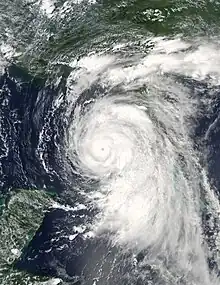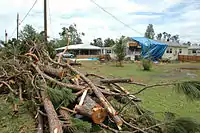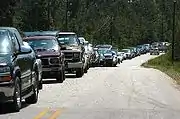Effects of Hurricane Dennis in Alabama
The Effects of Hurricane Dennis in Alabama included $127 million (2005 USD) in damage and three injuries. Dennis made landfall on the Florida Panhandle as a Category 3 hurricane on the Saffir-Simpson scale on July 10, 2005, before tracking over Alabama as a minimal hurricane.[1] In preparation for the storm, about 500,000 people were given evacuation orders, and the Red Cross opened 87 shelters. As a result, all southbound lanes of Interstate 65 from Mobile to Montgomery were closed.
.jpg.webp) Hurricane Dennis a few hours before landfall on July 10 | |
| Category 1 hurricane | |
|---|---|
| 1-minute sustained (SSHWS/NWS) | |
| Highest winds | 75 mph (120 km/h) |
| Overall effects | |
| Fatalities | None |
| Damage | $127 million (2005 USD) |
| Areas affected | Alabama |
Part of the 2005 Atlantic hurricane season | |
Hurricane Dennis caused modest damage in Alabama, mostly related to moderate wind gusts. Several counties within the state reported downed trees and powerlines, leaving a total of 280,000 people without electric power. Downed trees also left numerous county and state roads temporarily impassable. Maximum rainfall peaked at 12.80 in (325 mm) near Camden and top wind gusts surpassed 70 mph (110 km/h). Despite the damage, there were no fatalities, although three injuries occurred. Also, an unconfirmed tornado tore the roof off a home, forcing emergency workers to evacuate a man inside.
Storm history and preparations

On June 29, 2005, a tropical wave emerged off the west coast of Africa. Gradually, the system organized on July 2 and formed a broad low pressure area. The system continued to organize, and became a tropical depression on July 4. Tracking westward, it became a tropical storm on July 5 and a hurricane on July 7. Dennis rapidly intensified to attain Category 4 status on the Saffir-Simpson Hurricane Scale before making landfall on Cuba. The storm weakened to Category 1 status before re-emerging in the Gulf of Mexico and intensifying. Dennis made landfall on the Florida Panhandle on July 10 before tracking over Alabama as a minimal hurricane.[1]
On July 8, a hurricane watch was put into effect for coastal areas between the Pearl River and the Steinhatchee River.[2] Early on July 9, the hurricane watch was upgraded to a hurricane warning in anticipation of the storm.[3] Early on July 10 prior to Dennis' landfall, the warning was discontinued for locations between the Steinhatchee River and the Ochlockonee River, leaving Alabama within the advisory.[4] Just hours after the storm moved ashore, the warning was adjusted to include areas from the Alabama/Mississippi border to Destin, Florida.[5] On July 10, the coastal hurricane warning was downgraded to a tropical storm warning, although inland hurricane warnings remained in place.[1] At 2200 (UTC) on July 10, all tropical cyclone advisories were discontinued as the hurricane progressed inland.[1]
About 500,000 people were given evacuation orders in the state, mostly in coastal areas.[6] Residents in Mobile County, and those south of I-10 in Baldwin County, were ordered to evacuate. Similar orders were issued in Mississippi for parts of Jackson, Hancock, and Harrison counties, and for coastal areas in the Florida Panhandle stretching from Escambia County to Bay County.[7]
At 2300 (UTC) on July 9, 2005, all southbound lanes on Interstate 65 from Mobile to Montgomery were closed. Traffic was redirected, making all four lanes northbound to allow evacuations. Likewise, military installations such as NAS Pensacola, Whiting Field, Eglin AFB, Hurlburt Field and Tyndall AFB were all evacuated days before the storm.[8] Red Cross officials opened 87 shelters across the state which were able to hold about 14,000 evacuees.[8]
Impact

As Hurricane Dennis moved through the state, sustained winds reached minimal hurricane force in the interior of the state.[9] In total, 280,000 people in Alabama experienced power outages during the storm.[10] No deaths occurred, although Dennis caused three injuries[11] and total damage amounted to $127 million (2005 USD),[11] mostly due to structural damage. There was also severe damage to cotton crops.[12]
Rainfall typically ranged from 2–4 inches (51–102 millimetres),[13] although rainfall in localized areas reached 12.80 in (325 mm).[14] This caused numerous rivers to overflow causing widespread, locally major, flash flooding.[15] The rainfall flooded numerous state and county roads, some with water up to 5 ft (1.5 m) deep. Parts of Interstate 20 were overwashed with water, temporarily closing the highway. In Dallas County, a mudslide closed a section of State Highway 5.[15] In Greene County, the minor flooding was reported along the Tombigbee River. Throughout the region, numerous bridges were washed away several homes were flooded, sustaining major damage in some cases.[15]
Storm surge generally ranged from 3–6.5 ft (0.91–1.98 m), with the highest surge reported in Mobile Bay as winds became onshore during Dennis' landfall.[16]
A wind gust of 51 mph (82 km/h) was reported at Dothan, with minimum barometric pressure reaching 999.2 mb.[12] It is reported that the worst damage occurred in Escambia and Monroe counties. In the Escambia County city of Atmore, 100 percent of the city's residents lost electric power for some a period of time during the hurricane.[17] The strongest winds occurred in Escambia County, where gusts surpassed 70 mph (110 km/h), leaving numerous structures damaged or destroyed as Dennis tracked through the western half of the county.[18] One man in the county was injured by a fallen tree branch. Also, an unconfirmed tornado tore the roof off a home, forcing emergency workers to evacuate a man inside.[19] In Coffee County, local officials reported wind gusts had blown a carport into a wall of a house.[13] Marengo County received moderate damage, mostly limited to power outages and minor roof and structural damage caused by fallen trees and powerlines. Many customers were without electric power for at least a day, and numerous county roads were covered with debris.[20] A person was injured in Dallas County when a tree landed on their car. Five homes and one business were damaged due to high winds, and thousands of people county-wide experienced power outages.[21] Greene County reported hundreds of downed trees and powerlines causing County Roads 148 and 20 and State Highways 11, 43 and 14 to be temporarily closed. In Forkland, a mobile home caught fire when a powerline fell on the home. A motorist ran into a fallen tree in Boligee although did not sustain injuries.[22] In Perry County, 2,200 homes were without electric power for several hours, and several vehicles and homes were damaged.[23] A structural fire occurred in Russell County and was believed to be ignited by downed powerlines.[24]

Wind gusts in Autauga County surpassed 50 miles per hour (80 km/h), causing $180,000 dollars (2005 USD) in damage.[25] The Robinson Springs United Methodist Church had part of its roof torn off in Elmore County, while numerous other homes sustained roof damage.[26] One person was injured in Montgomery County when a tree fell on their vehicle.[27] Another person was injured in Clay County when he ran his vehicle into a downed tree.[28] A structural fire occurred in Randolph County as a result of fallen powerlines.[29]
Aftermath

Shortly after Hurricane Dennis made landfall in Florida, President George W. Bush ordered the federal government to provide necessary disaster resources and assets for the state to aid people who were affected by the storm. Also, 45 counties in the state were eligible for federal funds to pay 75 percent of the approved costs for debris removal and emergency protective services related to the hurricane, including requested emergency work undertaken by the federal government.[30] On July 11, Escambia County joined Baldwin and Mobile counties to be eligible to receive individual assistance funds.[31]
Shortly after, on July 13, two Disaster Recovery Centers opened to provide information to those who have suffered damage.[32] The next day, state and federal community relations teams were deployed into Alabama's disaster-declared counties, to assist residents who suffered from Dennis. The Alabama Emergency Management Agency (AEMA) and the Department of Homeland Security's Federal Emergency Management Agency (FEMA) had 20 federal community relations specialists and their state counterparts working in the disaster areas.[33] Subsequently, three more Disaster Recovery Centers became scheduled to open on July 16.[34] On July 25, four Disaster Recovery Centers in Alabama were scheduled to close.[35] By August 19, over $4 million (2005 USD) in individual assistance funds were received.[36]
See also
References
- Jack Beven (2005). "Tropical Cyclone Report: Hurricane Dennis" (PDF). National Hurricane Center. Retrieved 2008-04-01.
- Beven (2005). "Hurricane Dennis public advisory number 17B". National Hurricane Center. Retrieved 2008-04-01.
- Avila (2005). "Hurricane Dennis public advisory number 19". National Hurricane Center. Retrieved 2008-04-01.
- Franklin (2005). "Hurricane Dennis public advisory number 26". National Hurricane Center. Retrieved 2008-04-01.
- Franklin (2005). "Hurricane Dennis public advisory number 24B". National Hurricane Center. Retrieved 2008-04-01.
- Ken Kaye and Linda Kleindienst (2005-07-09). "Hurricane Dennis slams South Florida; 700,000 evacuated". South Florida Sun-Sentinel (Fort Lauderdale, FL). Retrieved 2008-04-01.
- Amy Sieckmann (2005). "Dangerous Dennis". Anniston Star. Retrieved 2008-04-01.
- Garry Mitchell (2005-07-11). "Shelters on the Gulf Coast fill up as Dennis strengthens". USA Today. Retrieved 2008-04-01.
- Hurricane Research Division (2008). "Chronological List of All Hurricanes which Affected the Continental United States: 1851-2005". National Oceanic and Atmospheric Administration. Archived from the original on 2008-09-21. Retrieved 2008-04-03.
- International Herald Tribune (2005). "Hurricane Dennis pounds Alabama-Florida coast". Retrieved 2008-03-31.
- National Climatic Data Center (2005). "Search results for Hurricane Dennis event reports". Archived from the original on 2006-04-17. Retrieved 2008-03-31.
- National Climatic Data Center (2005). "Event report for Hurricane Dennis (2)". Archived from the original on 2009-06-18. Retrieved 2008-03-30.
- National Climatic Data Center (2005). "Event report for Hurricane Dennis". Archived from the original on 2011-05-20. Retrieved 2008-03-20.
- David Roth (2005). "Rainfall Summary for Hurricane Dennis". Hydrometeorological Prediction Center. Retrieved 2008-04-01.
- Birmingham National Weather Service (2005). "Hurricane Dennis". National Weather Service. Archived from the original on August 15, 2007. Retrieved 2008-04-19.
- Beeler/Shepherd (2005). "Post-tropical cyclone report: Hurricane Dennis". National Weather Service. Archived from the original on August 17, 2007. Retrieved 2008-04-19.
- NCDC (2005). "Hurricane Dennis". Retrieved 2008-04-02.
- National Climatic Data Center (2005). "Event report for Hurricane Dennis (10)". Archived from the original on 2011-05-20. Retrieved 2008-03-31.
- The Herald Tribune (2005). "Hurricane Dennis pounds Alabama-Florida coast". Retrieved 2008-04-19.
- National Climatic Data Center (2005). "Event report for Hurricane Dennis (5)". Archived from the original on 2011-05-20. Retrieved 2008-03-30.
- National Climatic Data Center (2005). "Event report for Hurricane Dennis (6)". Archived from the original on 2011-05-20. Retrieved 2008-03-30.
- National Climatic Data Center (2005). "Event report for Hurricane Dennis (7)". Archived from the original on 2011-05-20. Retrieved 2008-03-31.
- National Climatic Data Center (2005). "Event report for Hurricane Dennis (8)". Archived from the original on 2011-05-20. Retrieved 2008-03-31.
- National Climatic Data Center (2005). "Event report for Hurricane Dennis (9)". Archived from the original on 2011-05-20. Retrieved 2008-03-31.
- National Climatic Data Center (2005). "Event report for Hurricane Dennis (11)". Archived from the original on 2011-05-20. Retrieved 2008-03-31.
- National Climatic Data Center (2005). "Event report for Hurricane Dennis (12)". Archived from the original on 2011-05-20. Retrieved 2008-03-31.
- National Climatic Data Center (2005). "Event report for Hurricane Dennis (13)". Archived from the original on 2011-05-20. Retrieved 2008-03-31.
- National Climatic Data Center (2005). "Event report for Hurricane Dennis (15)". Archived from the original on 2011-05-20. Retrieved 2008-03-31.
- National Climatic Data Center (2005). "Event report for Hurricane Dennis (16)". Archived from the original on 2011-05-20. Retrieved 2008-03-31.
- FEMA (2005). "President Declares Major Disaster For Hurricane-Battered Alabama". Retrieved 2008-04-01.
- FEMA (2005). "Escambia County Alabama Eligible For Individual Assistance". Retrieved 2008-04-01.
- FEMA (2005). "Alabama Disaster Recovery Centers to Open". Retrieved 2008-04-01.
- FEMA (2005). "State And Federal Disaster Workers Go Door To Door In Affected Communities". Retrieved 2008-04-01.
- FEMA (2005). "Disaster Recovery Centers to Open". Retrieved 2008-04-01.
- FEMA (2005). "Disaster Recovery Centers In Alabama Are Closing". Retrieved 2008-04-01.
- FEMA (2005). "More Than $4 Million in Assistance Issued in Alabama". Retrieved 2008-04-01.